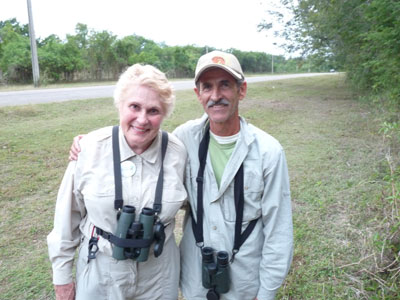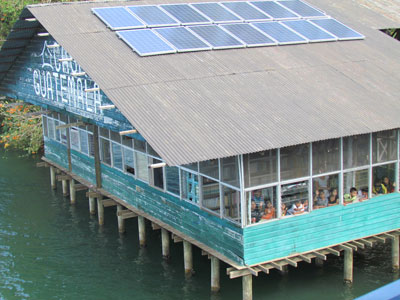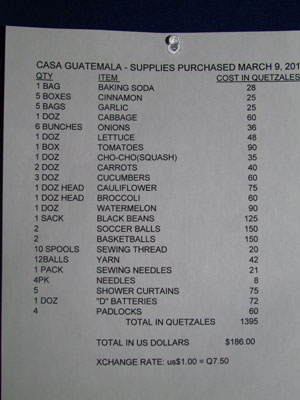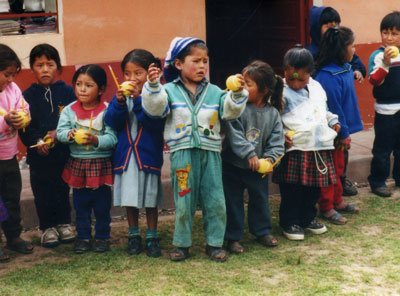Traveling and giving
My husband, Peter, and I went on a bird-watching trip all over Cuba in January 2010. Before departing, I canvased all the husbands of my friends for baseball caps they no longer wore. These I washed and dried and packed along with some baseballs that I bought at a discount sports store.
As we traveled around the country, I gave caps to local guides and our bus drivers. With the baseballs, whenever we saw a game in progress, which usually was on a Sunday and in baseball fields on the outskirts of small towns, we had our bus stop. Then we would walk to the fence and hold up the balls.
Soon a member of each team would approach us and heartily thank us for the gifts. Some had been playing with torn and tattered old balls. As you know, baseball is the national sport in Cuba.
Before the trip, I had asked my manicurist for new bottles of nail polish that she hadn’t used or had oversupplied herself with. I gave these along with several good toothbrush samples from my dentist to the chambermaids in each hotel (we changed hotels frequently while birding). All seemed to appreciate them.
I had purchased several inexpensive lipsticks from my local pharmacy as well and included one or two of these.
Linda Beuret
Santa Barbara, CA
Here’s an easy-to-use UK website that gives all the needed information on the subject of donating supplies when traveling: www.stuffyourrucksack.com.
I just went to the site and typed “Siem Reap” in the search area. The contact information for about six charities appeared for different types of needs. They included schools, a children’s’ village, a land mine museum, a charity run by monks to give people food and money for school uniforms, etc.
I have used this site when traveling on different occasions. Some charities will state on the website what they specifically want at that point in time (medicine, notepaper, craft supplies). Others have e-mail addresses so you can contact them.
Another part to the Stuff Your Rucksack Foundation is that it encourages travelers to report any charity groups that one encounters that could use a bit of help. If you find a group of Irish nuns trying to medically care for Kenyans on almost no funds (as I did), then this would be a great one to put up on that website.
For a nurses’ trip to South Africa that I went on in May 2008, we were told to take school supplies. Had I checked beforehand on this website, I would have seen that the school particularly wanted children’s books in English. This would have saved me over $40 in postage mailing my sons’ books (that they had outgrown) to Cape Town after my return.
On a trip to Myanmar, our local guide asked for any leftover children’s medication so he could give it to his friend, a pediatrician who often treated kids for free. On the way to the airport, I gave him our leftover medications.
On multiple trips to Thailand, Myanmar, Laos and Cambodia that my two young sons and I made from 1999 to 2005, we took antibiotics and other supplies, along with new McDonald’s Happy Meal toys, to various clinics. I hit up the pharmaceutical reps beforehand and had a nice stash of medications. I took only meds that would be used for a short time, like antibiotics, children’s cough syrup or Tylenol, none for chronic conditions.
Of course, local guides can steer you to clinics. I also found clinics and a maternity hospital by asking front desk personnel at our hotels.
Before my second visit to Rarotonga, around 2002, I read about a cat clinic/shelter in the Cook Islands, so I took cat food and almost-expired eye ointment and other feline meds that I got from my vet. The receptionist at my hotel was so happy about this that she said she would take the supplies right over to them.
Nanci Scheithauer
Santa Fe, NM
Over the years, I have found that shoes are some of the best items to give people in third-world countries. This has held true for me through Southeast Asia, South America and Africa.
Socks are also a great gift. One of my travel mates, Mike, owned a hosiery company, so we always gave away dozens of socks on our trips through various countries.
Nowhere were the gifts so well received as in South Africa on a July-August ’13 visit. Our friends in Cape Town had a domestic come in three times a week. We gave her all of our clothing, post safari, along with shoes, socks and tons of beige safari wear.
Our hosts told us that the very next day she had on the sandals I left her! I think more travelers should do this.
Gerry Kataoka
Pleasant Hill, CA
The first experience traveling and giving that my wife, Glenda, and I had was on a trip to Papua New Guinea with Elderhostel (now known as Road Scholar; Boston, MA; 800/454-5768) in 2001. Group members were asked to bring supplies for a particular school as well as used clothing.
We bought a variety of multipacks of school supplies at Costco, such as pencils, pens, scissors, erasers, adhesive tape, etc. There were only 14 travelers and the tour director on this trip, but we were able to leave a fair amount of supplies when we visited the school.
At a lodge where we stayed, we left the suitcase of used clothing to be distributed by the staff. During that trip, we observed roadside stands selling used clothing, obtained, we were told, from Goodwill Industries in the US.
On an Elderhostel trip to Easter Island in 2004, we were asked to bring reading materials in English to help the Polynesian students at a school learn the language. Books and magazines are heavy, so, considering airline weight limitations, that was a problem. Instead, we mailed a box of National Geographic magazines after we returned home, which was expensive.
On a fishing trip in the Sea of Cortez during a 2009 vacation in Loreto, Baja California, Mexico, a large fishhook got stuck in my right leg. The hook was expertly removed by paramedics at the dock.
Their supply of surgical instruments was quite limited, so, after returning home, we mailed an assortment of supplies to our Loreto bed-and-breakfast hosts. It was never received, however, getting lost or appropriated in transit. There was no recourse because we had not insured the package.
For two Pacific Ocean cruises on the Spirit of Oceanus of Cruise West (now defunct) — from Fiji to Guam in 2006 and from Fiji to Tahiti in 2009 — passengers were asked to bring school and medical supplies.
The school supplies were given by the crew to schools in poor villages, while the medical supplies were given to clinics on remote islands, where the ship’s doctors went ashore and treated locals who had medical problems.
On two cruises with Blount Small Ship Adventures (866/416-1228) along the coasts of Belize and Guatemala in 2011 and 2013, passengers were asked to donate money for Casa Guatemala, an orphanage and boarding school we visited up the Rio Dulce. The crew then delivered supplies, food, clothing, etc.
In 2011, the crew collected $186 from the 30 passengers. It was amazing how much could be bought with those few dollars. In 2013, $1,058 were collected from 71 passengers.
After the 2011 cruise, we stayed four nights at the Lamanai Outpost Lodge near the Lamanai Mayan ruins in northern Belize. Before our trip, we learned on the Internet about the nearby village of Indian Church, that its school would welcome donations and that the local population could use used clothing. So we bought about $100 worth of school supplies at Costco and packed them with used clothing in a large duffel bag.
At the Belize City airport, however, we were surprised that we had to declare the school supplies to Belizean Customs. The Customs officer considered them merchandise that we could sell in Belize. He checked the duffel bag briefly, then told us we had to pay a 2% import fee plus a sales tax.
The lady at the payment window first calculated that to be US$26.75, or almost 27% of the declared value. I objected because that did not seem right; the sales tax was only around 13%. She recalculated and came up with US$15, which I did not like either but paid. It took 45 minutes to get through Customs.
Nevertheless, we enjoyed visiting the Indian Church government school, which had only three classrooms for grades one through six, and talking to the teachers and children. We left the clothes with the school librarian for distribution in the village.
Albin Brandstetter
Springfield, OR
I agree wholeheartedly with Debbie Jefkin-Elnekave (a tour company operator with a policy against travelers’ giving trinkets, candy or money, instead encouraging participants to focus on cultural interactions — Nov. ‘13, pg. 45), unless there is an easy and unself-conscious way to be generous.
On this subject, here is an organization which is good: Pack for a Purpose.
When my wife, Jeanie, and I know that we are going to have a guide — such as in Vietnam, Thailand, Costa Rica, Uganda and, most recently, in 2012, in Syria — we do often take baseball hats for guides and drivers so that they, too, can be members of RSN (Red Sox Nation).
Brooks Goddard
Needham, MA
For trips abroad, we have occasionally packed items, such as pencils, pens and composition books, for schoolchildren. On one occasion, after returning home from a safari to East Africa with our children and grandchildren, our family shipped a large box of school supplies and books in English to a school we had visited while in Tanzania.
The circumstances we wish to describe to you, however, occurred on a trip to Bolivia and Peru, including a cruise on the Amazon River, with Overseas Adventure Travel (Cambridge, MA; 800/955-1925) in November-December 2006.
In Lima, Peru, our group was scheduled to visit a typical “shanty town,” one that was very well organized, with its own governing body. Our program director suggested that, if we wished, we could visit the local food market and buy fresh foods to contribute to the commune in appreciation for their allowing us to visit. We did so, and the residents were very appreciative of our contributions to their food pantry.
The children of the commune, by the way, were delightful, some speaking English.
Later on the trip, we were scheduled to visit a school on the banks of the Amazon. Again our program director suggested we purchase, in Iquitos, some school supplies to donate to the children. We each pitched in a few dollars and he purchased the items that he knew they could use (e.g., pads, pencils, crayons, etc.). The children and their teacher were very happy to receive our gifts and sang for us during our visit.
We felt that this method of presenting gifts, purchased locally with the assistance of someone who knew what would be appreciated and used, was superior to packing gifts with us on the trip. US dollars were widely accepted in Peru, provided the bills were of small denominations and reasonably crisp.
Dan & Dee Crough
Newtown Square, PA
On my travels, which have taken me to South America, Africa and Southeast Asia, I always take gifts in an extra carry-on bag. Most often I take crayons and paper for the children, but when I traveled to Kenya I took T-shirts and caps and hats.
In Morocco in March 2003, I saw boys playing soccer with rocks, so I decided to purchase several soccer balls for them. My guide, Mohammed, took me to a general store in a village near Ouarzazate. The soccer balls were deflated, so I also purchased a pump for the boys to use.
The gift that was most memorable — I took used tennis balls to Peru and passed them out at an elementary school. Because of the altitude, the balls were bouncing very high. The kids and adults went crazy. I am not sure who enjoyed the balls the most: the mothers, the kids or my fellow travelers.
That was in November 2001; my husband, Carl, and I were traveling with Overseas Adventure Travel (Cambridge, MA). One woman on the tour said it was the best part of the trip, and we had traveled to see Machu Picchu and the Galápagos Islands!
I have never given gifts at random but offer them to a school or an orphanage with permission from the person in charge. I do not donate money, as I am not always sure how it is used. One guide recommended we not give money, as some of the adults in the school or orphanage may use it for their own purposes.
Lorna Tjaden
New Hope, MN
Regarding taking gifts and helpful items from home to give away when traveling, my husband, George, and I have had mixed results with this. Of course, it feels good to take people things they want and need, but we’ve wondered if generous travelers weren’t inadvertently creating a monster (such as kids who have been “trained” to expect pens, for example) or, worse, sending a wrong, even patronizing, message.
A side issue — I have a problem with handing out cute but useless things to kids, especially to kids who might well have significant needs that could be addressed by better-targeted generosity.
This was brought home to us during an encounter George and I had in Botswana in June ’13. We met a very nice group of young South Africans who were on a road rally to raise money to buy shoes for children. I asked several of these young people what the name of the charity was. After some consultation, they came up with the name, but why the charity’s goal was obtaining shoes for kids or which kids would receive them or when or where that would happen was anyone’s guess.
We politely asked them if they were aware that in nearby Tanzania, some 45% of the population did not have access to safe drinking water. The year before, we had seen the scummy green pools from which people and animals were drinking, an image not to be forgotten.
On the Tanzania trip, instead of taking stuff from home, we stopped in Arusha and donated American dollars — THE most welcome gift! — to Safe Water Ceramics of East Africa to buy locally made purifiers.
But I won’t be too preachy here. In addition to taking greenbacks, we always travel with a few little things that fit in my daypack and can be given spontaneously. I always carry a bag of individually wrapped hard candy to share.
The all-time biggest hits have been little sparkly things, like clips for the hair. Men, women and children the world over seem to love things with a bit of sparkle!
My husband takes tire pressure gauges. They’re small, lightweight and most appreciated by men.
If we have clothes like safari pants that wear out during a trip, we have them laundered and leave them. But we can’t see traveling with extra bags of stuff to give away.
Anne Stoll
Claremont, CA
Giving is a big part of travel, for me. I’ve taken, as gifts, everything from stuffed animals to laptop computers. Taking things can be great fun, but its real usefulness is very limited. We just don’t know what’s really needed, and, often, equivalent products can be purchased locally for less, a lot less.
I have come to realize two truths. First, there is only one gift that really and always makes a difference: 100-dollar bills. A nice, fresh, 100-dollar bill always brings real joy to those serving the many poor. Taking currency is SO easy — no luggage problems. Yes, money can be misused, but so can anything.
Second, locate and get to know your recipient in advance. If the organization knows you’re coming, you may receive a wonderful reception. I’ve been hugged, fed and serenaded! These events often turn out to be the highlights of trips.
How do you locate a suitable charity? Virtually all organizations have websites and email. It’s great fun to make finding a recipient a key part of trip planning.
As a Rotarian, I often use the resources of Rotary International. There is a Rotary club in virtually every city, rich or poor, with members who know the turf. Rotary is also committed to high ethical standards. Go to the rotary website, find a club and contact its representative. At least half the clubs will welcome you with amazing suggestions.
Because of my Rotary involvement, I have pretty good resources for finding recipients in a number of countries, specifically, the Philippines (excellent contacts), Zimbabwe, Tanzania, Thailand, Bangladesh, Mexico and Colombia. I would be very happy to help travelers locate a charity they like. Contact me by e-mailing or calling ITN.
Pack light, include a couple crisp hundreds and have a joyous adventure!
Ed Graper
Goleta, CA




